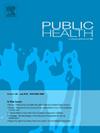Association between trajectories of life-course group sports participation and dementia: A 3-year longitudinal study
IF 3.9
3区 医学
Q1 PUBLIC, ENVIRONMENTAL & OCCUPATIONAL HEALTH
引用次数: 0
Abstract
Objectives
The evidence for a causal effect of physical activity (PA) on dementia risk remains inconclusive. Group sports participation may impact dementia risk differently compared to PA. This study aimed to examine the association between long-term group sports participation trajectories across the life course and dementia onset among older Japanese adults.
Study design
Cohort study.
Methods
This cohort study included 8277 adults aged ≥65 years from the Japan Gerontological Evaluation Study. Life-course group sports participation was assessed through self-reported questionnaires, and Group-Based Trajectory Modelling (GBTM) was used to identify participation trajectories. Dementia onset was determined using public long-term care insurance-system registries, and Cox proportional hazards models were employed to assess associations between trajectory groups and dementia onset.
Results
GBTM identified four trajectories: persistently low (n = 5164, 62.4 %), dropout after high school (n = 2150, 26.0 %), dropout after young adulthood (n = 446, 5.4 %), and increase in midlife (n = 517, 6.2 %). During a mean follow-up of 3.2 years, 311 participants developed dementia. After adjusting for confounders, the dropout after young adulthood group had a significantly higher dementia risk than did the persistently low group (hazard ratio, 95 % confidence interval, 1.85, 1.09–3.16). No significant differences were observed between the dropout after high school (1.13, 0.84–1.52) and the increase in midlife (1.36, 0.78–2.39) groups compared to the persistently low group.
Conclusions
The risk of dementia may vary depending on life-course group sports participation patterns. Further studies are needed to establish these findings, including examining specific types of sports and individual PA levels.
一项为期3年的纵向研究:生命周期团体运动参与轨迹与痴呆之间的关系。
目的:体力活动(PA)对痴呆风险的因果影响的证据仍不确定。与PA相比,团体运动参与对痴呆风险的影响可能不同。这项研究旨在研究日本老年人在整个生命过程中长期集体运动参与轨迹与痴呆症发病之间的关系。研究设计:队列研究。方法:本队列研究纳入来自日本老年学评价研究的8277名年龄≥65岁的成年人。采用自我报告问卷的方式评估生命历程群体体育参与,采用基于群体的运动轨迹模型(GBTM)识别参与轨迹。使用公共长期护理保险系统登记处确定痴呆发病,并采用Cox比例风险模型评估轨迹组与痴呆发病之间的关联。结果:GBTM鉴定出四种轨迹:持续低(n = 5164, 62.4%)、高中后辍学(n = 2150, 26.0%)、青年后辍学(n = 446, 5.4%)和中年后辍学增加(n = 517, 6.2%)。在平均3.2年的随访期间,311名参与者患上了痴呆症。在调整混杂因素后,青年后辍学组的痴呆风险显著高于持续低水平组(风险比,95%置信区间,1.85,1.09-3.16)。高中后辍学率(1.13,0.84-1.52)和中年辍学率(1.36,0.78-2.39)与持续低辍学率组相比无显著差异。结论:痴呆的风险可能因生命周期团体运动参与模式的不同而不同。需要进一步的研究来证实这些发现,包括检查特定类型的运动和个人的PA水平。
本文章由计算机程序翻译,如有差异,请以英文原文为准。
求助全文
约1分钟内获得全文
求助全文
来源期刊

Public Health
医学-公共卫生、环境卫生与职业卫生
CiteScore
7.60
自引率
0.00%
发文量
280
审稿时长
37 days
期刊介绍:
Public Health is an international, multidisciplinary peer-reviewed journal. It publishes original papers, reviews and short reports on all aspects of the science, philosophy, and practice of public health.
 求助内容:
求助内容: 应助结果提醒方式:
应助结果提醒方式:


